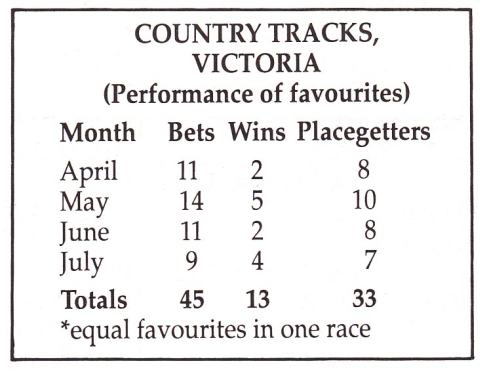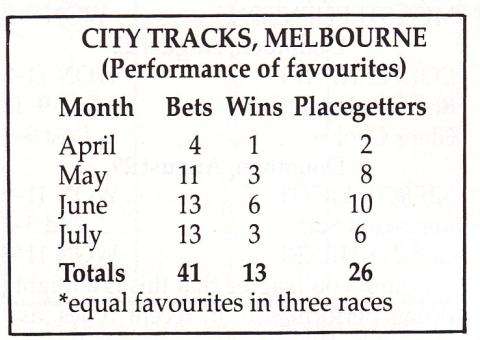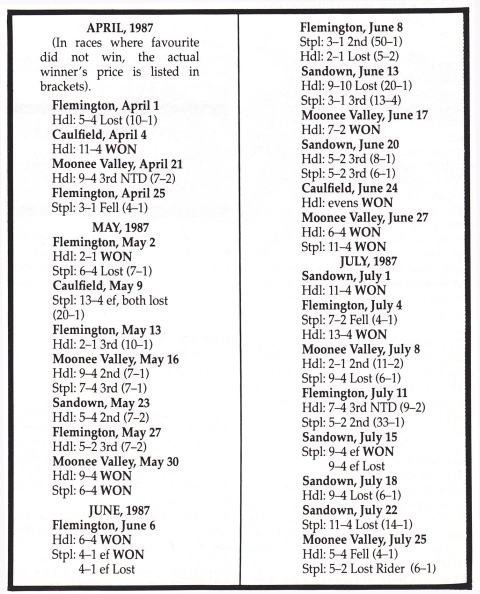The problem, most people say, is that jumps races provide an added 'hurdle' for the punter-your horse may not reach the finish! So true-but how many times does, for example, the favourite fall, lose the rider or get pulled up in a race?
This was just one of the questions I tried to solve in a test of jumps races in Victoria over a four-month period April, May, June and July of 1987. This is the peak time for jumps races and I thought it would provide us with some accurate answers.
To dispose firstly of that initial question: I checked 44 country races in that test period, including all the minor tracks (non-TAB meetings) and only two of the favourites failed to finish. One fell, the other was pulled up. Not bad really. At the four city tracks in Melbourne, there was a total of 38 races and in these there were three favourites which fell, and one that lost its rider. Overall, then, a total of 82 races and six favourites failed to finish. This is about eight per cent. Maybe it isn't as big a problem as we might have supposed?
In the test period, I checked out all the favourites. On the country tracks the result was as follows (when placegetters are listed they include the winners):

The performance of the favourites on the city tracks, Moonee Valley, Sandown, Flemington and Caulfield, was as follows:

The prices of the winning favourites are, naturally, of enormous importance. They tended to be shorter in the country races, which, I suppose, is to be expected. There was no winning favourite in the country longer than 4-1, but most were much shorter. In the city, the longest price for a winning favourite was 4-1, but there were a few at 7-2,11-4 and 13-4.
The figures are as follows:
FLEMINGTON(Favourites)
15 bets, four wins (6-4, 4-1, 2-1, 13-4), nine placegetters.
Stake 15 units, Return 14.75 units. LOSS 0.25 units.
MOONEE VALLEY(Favourites)
12 bets, five wins (7-2, 6-4, 11-4, 9-4, 6-4), nine placegetters.
Stake 12 units, Return 16.5 units. PROFIT 4.5 units.
SANDOWN(Favourites)
10 bets, two wins (11-4, 9-4), six placegetters.
Stake 10 units, Return seven units. LOSS three units.
CAULFIELD(Favourites)
Four bets, two wins (evens, 11-4), two placegetters.
Stake four units, Return 5.75 units. PROFIT 1.75 units.
Overall, then, only a loss situation at Flemington (almost broke even) and Sandown. There was a total of three units profit on a turnover of 41 units. Not much, but a profit ....
In the country, the winners' prices were as follows: 5-2, 4-5, 4-1, 5-4, 5-2, 6-4, 5-2, 4-6, 11-8, 5-4, evens, 4-7 and 6-4. These prices failed to make a level-stakes profit. I must point out that I included all minor Victorian tracks in my test. I wanted to get an overall picture of how favourites fared in the jumps races.
It's in the city, however, that we should be concentrating our attention. Here is the EXPLOSIVE news! You should concentrate on HURDLE FACE FAVOURITES on the city tracks. They are the ones to provide the dynamite profits.
Let me explain: Of those jumps favourites in the test period, 22 were in hurdle races. From those 22 bets, there were NINE winners and 17 placegetters (including the winners). This is a fantastic record. On level stakes of one unit a win on each hurdle favourite, the profit was 7.5 units.
But now for the GOOD news-bet only on those favourites at 5-2 or better and you would have achieved this result:
BETS ON HURDLE FAVOURITES (5-2 or longer in betting)
WON 7-2
3rd 5-2
3rd 5-2
WON 11-4
WON 13-4
WON 11.4
Total: six bets, four wins, six placegetters.
Winners: 66 per cent, placegetters 100 per cent.
Stake (one unit win each) six units, Return 16.25 units.
PROFIT. 10.25 units.
How about that for a profit? You've had just six bets over four months, but they've been 'ace' investments-returning a profit of close to double your investment. Had you had $100 a win on each of the six horses you would have won $1025. Had you backed them all each-way, the profits would have been greater.
What if you had backed them on a ratio of two units a win and five units a place? Your win profit would have been 20.50 units. You would have outlaid 30 units on the place for a return of around 47 units, a profit of 17 units. Now, I have worked out the place returns on REDUCED prices.
Thus, I assumed betting each-way you would get only 2-1 about the 5-2 chances, 5-2 about the 7-2 winner, 9-4 about the 11-4 winner, and 5-2 about the 13-4 winner.
I think this is reasonably realistic. Altogether then, on a 2-5 betting ratio, you have won 20.50 on the win bets and another 17 on the places, a total of 37.50 on a stake of 42 units. This is very close to 100 per cent return!
Of course, hurdle race favourites may fall in a hole at some time and stop winning-that's the unknown factor. It may pay you to delve even further into this aspect. How have they fared over a 12-month period? A two-year period?
There certainly seems to be a case for cautious excitement about hurdle race favourites generally, but especially those at 5-2 and longer in the betting. Six out of six isn't bad!
Backing all the favourites on city tracks when they are 5-2 and over can also be profitable. Flemington threw up eight bets for three winners and six placegetters and a profit on level stakes of 3.75 units. At Moonee Valley, there were three bets for two winners and a 5.25 units profit. There was a loss of 1.25 units at Sandown on five bets, one winner and four places. Caulfield gave a profit of 0.75 units on three bets and one winner.
The full record of the city hurdle and steeple favourites in the test period is as follows:
 By Martin Dowling
By Martin Dowling PRACTICAL PUNTING - FEBRUARY 1988